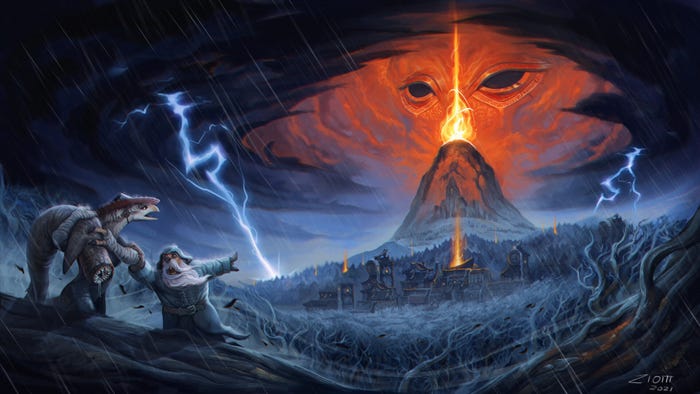"We’re requiring players to unlearn something...taught by almost every other strategy game," says dev Justin Ma. "That losing your mechs or main characters is the worst thing that can happen."

What’s in a failstate?
For many games, from RPGs to tactics games, failure comes with the death of your characters. Your party might have met a sticky end in the bowels of a dungeon, or your fighters might have perished at the hands of mercenaries in a battle. Success, on the other hand, is getting them through unscathed.
Into the Breach, the excellent new turn-based mech tactics game from Subset Games, developer of FTL: Faster Than Light, is different.
“We’re requiring players to unlearn something that’s been taught by almost every other strategy game, which is that losing your mechs or main characters is the worst thing that can happen,” says artist and co-designer Justin Ma.
Into the Breach blends the Rogue-like progression of FTL, in which you must survive and upgrade your squad of three mechs to meet an ever-rising threat, with intricate tactics-style puzzling as you out-maneuver and out-think your adversary, the Vek, giant insects which burst from the ground and are hellbent on destroying humanity.
But your fortunes don’t rest on your mechs, which are fundamentally expendable. Instead, they rest on the cities of civilians that the Vek are attacking. For every one that falls to their attacks you’ll lose one point from your Power Grid, and when you have no points left, it’s game over. It’s therefore this gauge that underscores all your choices in the game, as you decide between saving a city and putting your mechs into danger.
How to make players care about cities
“Collateral damage to the buildings was always an important part of the game,” says co-designer and programmer Matthew Davis.
The original inspiration for Into the Breach was the observation that in most superhero movies, cities are destroyed in huge fights and no one seems to care. What if they could make a game in which you were tasked with protecting cities during giant-scale battles?
"At the end of the day, any amount of atmosphere you can put over the top of something is going to be shallow compared to tying it to an important mechanic like your health."
But to get players to care about defending cities wasn’t as easy as it might seem. Development on Into the Breach began in earnest in early 2014 when Subset finally finished FTL’s iPad port, and Ma and Davis began sketching out ideas for how they could give buildings a sense of importance by making them look pretty or by showing the body count when they’re destroyed.
“But at the end of the day, any amount of atmosphere you can put over the top of something is going to be shallow compared to tying it to an important mechanic like your health,” says Davis.
They toyed with the game being about protecting a single city which would evolve over time, with players having to build structures and repair them when they were damaged, making them matter because they’d just taken a chunk of resources to build them up.
“That didn’t feel very good,” says Ma.
“Yeah, it still didn’t come together in a way we liked,” adds Davis.
But focusing enemies’ attentions on the city did tie together well with the core mechanic that was steadily evolving for the game, namely, the idea that players always know where the enemy are attacking next so each turn they have a chance to disrupt them before they unleash havoc. But when the mechs were the only target, they found that the threatened havoc was trivial, because all the mechs needed to do was to walk away.

“The only way to make it difficult was to flood the board with enemies and danger zones, which becomes needlessly complex and hard to parse,” says Ma. “That was the antithesis of what we were trying to do.” And so, around two years into development, the cities became the target.
“The most important thing to making a compelling game, for us personally, is if the storytelling, the atmosphere, the lessons it’s teaching you, are all directly tied to gameplay,” Ma continues. “If you’re trying convince me of something that has nothing to do with gameplay, it just doesn’t have anywhere near the impact when I’m making decisions that are tied to it.”
Designing shifting priorities
From turn to turn, Into the Breach is a game of shifting and painful decisions as you weigh up the pros and cons of your situation. Many factors are important. At the top of the pile is your overall health, the Power Grid, which when full is just seven points, so at best you’re only seven cities away from the apocalypse.
Every other priority is up for change, depending on what threats the Vek present. In each battle you’ll have bonus objectives which will award you certain vital resources if you succeed. Reputation buys new weapons and gear, Reactor Cores will power up your mechs, unlocking new abilities, and you can also earn more Power Grid points.
So you’ll often face situations in which you can either destroy the dam that will earn you a Reputation point or you can save a city from a Vek attack, but not both. Or you can earn a Power Grid point, but maybe that will destroy a mech.

To balance the relative importance of these general priorities, Subset tried various lengths of the bar, including a system by which players could upgrade its length. But they found that by the end of the game it could get so long that players would start not to care about doing damage to it.
“Once your power bar becomes twice as long, it doesn’t have as much value as killing the monster, and so you no longer have that decision. It’s always worth the collateral damage of punching the monster into the building,” says Davis.
To respond to that, they considered scaling up the number of buildings on the map and the amount of damage enemies could do to them, and then that meant also scaling up the player’s potential for recovering from damage. “When you look at it all you think, ‘Why are we even scaling it if absolutely everything has to scale evenly?’ Just keep it all low!” Ma says.
Making mechs matter less
And then there are your mechs. “Mechs do still matter in the sense that if they die you get punished with the pilot death,” says Davis. Pilots are separate from your mechs, and as they make kills they’ll earn XP which grant extra hit points and movement, plus pilot-specific extra abilities, such as reducing incoming damage.
"When you have this interplay between buildings being important, mechs being important, objectives being important, it empowers interesting decision-making."
So when a mech is destroyed its pilot dies, taking with them their bonuses, but the mech will return for the next battle with an AI pilot which can’t earn XP. It’s therefore entirely viable to lose a mech if circumstances demand it, especially since you’ll likely be able to buy or find a new pilot anyway.
Similarly, Subset ensured that players used their mechs without too much concern for their wellbeing by automatically recouping their health after every battle. But before committing to that idea, they considered a repair system which costed resources to bring them back to strength.
“It makes you want to protect your mechs more,” says Ma. But it also reduced players’ inclinations to put them in harm’s way by, for example, blocking damage to cities. “So we felt it was more important to just gloss over and ignore the whole repairing of mechs concept and fully heal them after every battle so you can really use their health bar as a tool during the battle, rather than be worried every time you take damage.”
Hand-designing endless battles
While Into the Breach is systems-led, its battles aren’t played out on procedurally generated maps. “It was important to control the map design in a way that it didn’t generate maps that aren’t fun to play on,” says Davis. He knew that since they’re only 8x8 tiles in size, it would be much cheaper to hand-design 100 maps than to design a procedural system.

But he and Ma had to learn how to avoid maps which weren’t fun. “The most frustrating thing that can happen is to have situation where you have no options whatsoever to resolve,” says Ma. To an extent, objectives such as giving players special buildings to defend helps to widen the available priorities.
“Having these tough decisions where what you feel is the highest priority in a given situation changes because of a mission is one of the ways to make the game feel dynamic and interesting,” Ma continues.
But still, the maps had to be engineered so they didn’t throw up frustrating situations. Two buildings diagonally positioned from each other or in an L-shape is a big no-no, because if a Vek gets into the nook they form to attack a city, players have few options to deal with them. Many attacks push targets back, so they’d send it crashing into the very buildings the players should be defending.
“You need to always be able to manipulate them,” says Davis. “If the enemy is in a position where you can’t move it, then it becomes this unstoppable force and it’s not fun at all.”
It’s useful to think of Into the Breach as a game that throws out effectively endless puzzles, each turn presenting a thorny little problem in which you have to balance priorities to ensure your survival. But one thing is always clear: your Power Grid. Its clarity allows the rest of your priorities to constantly shift so you’re rarely sure of your best move while also knowing what’s genuinely bad. And that’s where Into the Breach becomes electric.
“If it’s just a simple experience where in every situation you want to do the same choice, it’s not much of a game to me,” says Ma. “You as a player don’t have much agency, you’re just a robot with a hierarchy of decision-making. So when you have this interplay between buildings being important, mechs being important, objectives being important, it empowers interesting decision-making.”
About the Author(s)
You May Also Like







